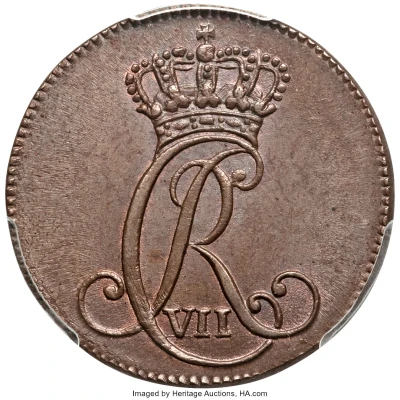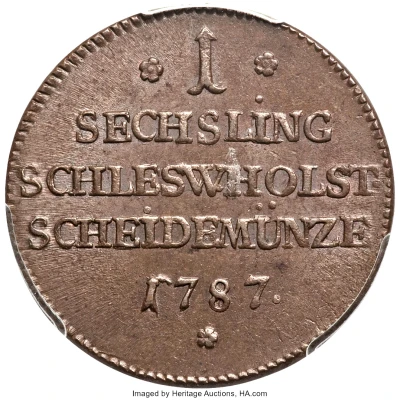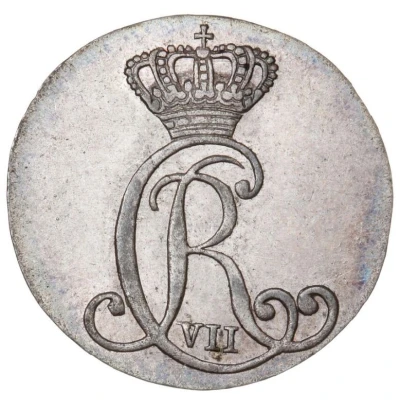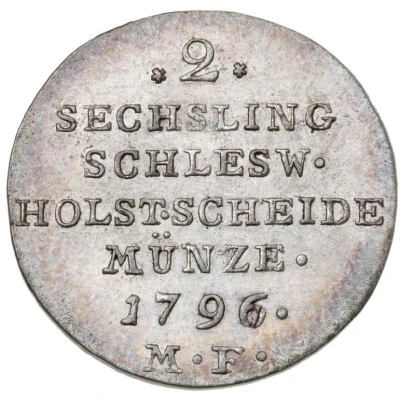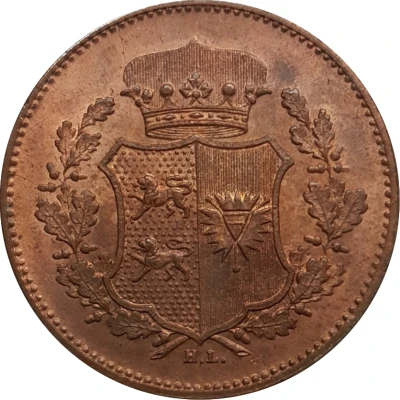
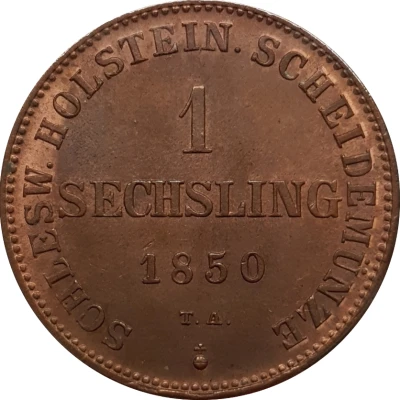

© gdch6ng
1 Sechsling Provisional Government Coinage
| Copper | 9.5 g | 27.1 mm |
| Issuer | Danish duchies of Schleswig and Holstein (German States) |
|---|---|
| Period | First Schleswig War (1848-1852) Rebel Provisional Government (1848-1852) |
| Type | Standard circulation coin |
| Years | 1850-1851 |
| Value | 1 Sechsling (1⁄120) |
| Currency | Speciesthaler (1787-1864) |
| Composition | Copper |
| Weight | 9.5 g |
| Diameter | 27.1 mm |
| Thickness | 2.2 mm |
| Shape | Round |
| Technique | Milled |
| Orientation | Medal alignment ↑↑ |
| Demonetized | Yes |
| Updated | 2024-10-05 |
| Numista | N#19525 |
|---|---|
| Rarity index | 33% |
Reverse
Value with date. Legend along rim.
Script: Latin
Lettering:
SCHLESW.HOLSTEIN. SCHEIDEMÜNZE
1
SECHSLING
1850
T. A.
*
Edge
Plain
Comment
The Schleswig-Holstein Question (German: Schleswig-Holsteinische Frage; Danish: Spørgsmålet om Sønderjylland og Holsten) was a complex set of diplomatic and other issues arising in the 19th century from the relations of two duchies, Schleswig (Danish: Sønderjylland/Slesvig) and Holstein (Danish: Holsten), to the Danish crown, to the German Confederation, and to each other. The British statesman Lord Palmerston.Schleswig was a part of Denmark during the Viking Age, and became a Danish duchy in the 12th century. Denmark repeatedly tried to reintegrate the Duchy of Schleswig into the Danish kingdom. Holstein, just on the other side of the Danish border from Schleswig, was in medieval times a fief of the Holy Roman Empire. From 1460 on, the two had been ruled together by a common Duke -- who was also the King of Denmark. The Treaty of Ribe, agreed to by the Danish King in order to gain control of the both states, seemed to indicate that Schleswig and Holstein were to remain united, though that interpretation was later challenged. The Holy Roman Empire was dissolved in 1806, but the German Confederation formed in 1815 also included Holstein. By the early 19th century, Holstein's population was almost entirely ethnically German, along with much of Schleswig's.
Both Schleswig and Holstein had been ruled through institutions separate from the rest of the Danish Kingdom. On March 27, 1848, Frederick VII of Denmark announced to the people of Schleswig the promulgation of a liberal constitution under which the duchy, while preserving its local autonomy, would become an integral part of Denmark. This led to an open uprising by Schleswig-Holstein's large German majority in support of independence from Denmark and of close association with the German Confederation. The military intervention of the Kingdom of Prussia supported the uprising: the Prussian army drove Denmark's troops from Schleswig and Holstein, beginning the First Schleswig War (1848–51), which ended in a Danish victory at Idstedt; with the London Protocol, the international community agreed on the Duchies' status.
A second crisis emerged due to a succession dispute. The Dukedoms of Schleswig and Holstein were legally inherited under Salic law which ignored females; the Kingdom of Denmark had a different inheritance law which permitted male heirs to inherit through the female line. Under these varying succession laws, the childless King Frederick VII of Denmark would have different heirs in Denmark and in Schleswig-Holstein. But when Frederick died in 1863, his Danish heir Christian IX claimed to have inherited the Duchies as well, and attempted to reintegrate the Duchy of Schleswig into the Danish kingdom by the signing the so-called November Constitution. This was seen as a violation of the London Protocol, and it led to the Second Schleswig War of 1864 and ultimately to the Duchies' absorption into Germany.
Following the defeat of Germany in World War I, the Danish-majority area of Northern Schleswig was finally unified with Denmark after two plebiscites organised by the Allied powers. A small minority of ethnic Germans still lives in Northern Schleswig, while a Danish minority remains in South Schleswig.
Interesting fact
One interesting fact about the 1 Sechsling coin from the Danish duchies of Schleswig and Holstein is that it was minted during a time of political turmoil in the region. The Provisional Government Coinage was established in 1850, following the outbreak of the First Schleswig War between Denmark and the German Confederation. The coin was intended to serve as a temporary currency for the duchies, until a more permanent solution could be established. Despite its temporary nature, the 1 Sechsling coin remains a unique and interesting piece of numismatic history.
Price
| Date | Mintage | VG | F | VF | XF | AU | UNC |
|---|---|---|---|---|---|---|---|
| 1850 TA | 203000 | - | - | - | - | - | - |
| 1851 TA | 163000 | - | - | - | - | - | - |
Values in the table are based on evaluations by sales realized on Internet platforms. They serve as an indication only for 1 Sechsling (Provisional Government Coinage) 1850-1851 coin.
